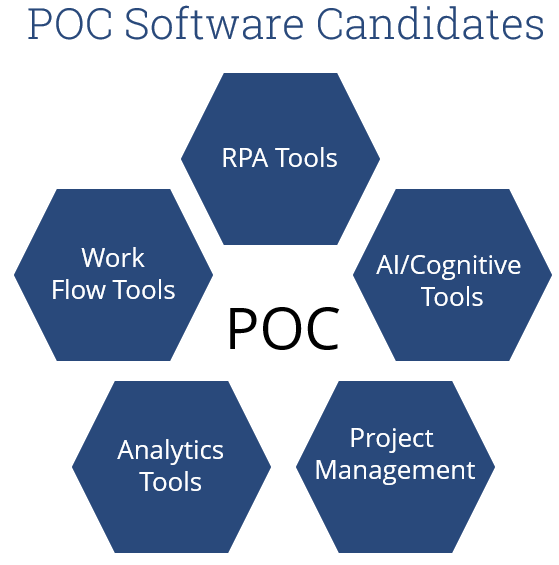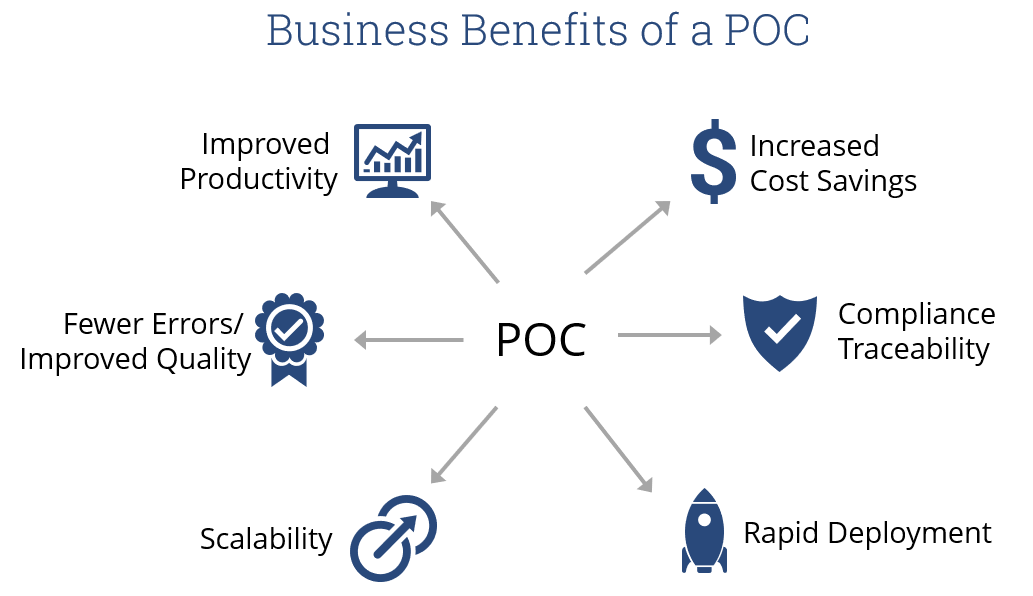Many businesses are intrigued by the idea of starting an enterprise-wide automation program but struggle to take the first step. For some, a proof of concept (POC) is the right catalyst. A POC allows a team to observe an automation solution working with existing systems, applications, data and processes in their target environment. The beauty of a POC is that it proves whether a solution will or won’t work in the confines of business’ customized environment. It also provides an opportunity to validate the software or platform selected and the commitment of the resources involved to ensure success of a larger program.
 Automation POCs can be performed with a variety of software platforms as shown in the graphic to the left. Robotic process automation (RPA) is a common first POC, but POCs also are valuable with desktop automation, optical character recognition (OCR), machine learning (ML), natural language processing (NLP) and others.
Automation POCs can be performed with a variety of software platforms as shown in the graphic to the left. Robotic process automation (RPA) is a common first POC, but POCs also are valuable with desktop automation, optical character recognition (OCR), machine learning (ML), natural language processing (NLP) and others.
POCs are quick to deploy and they require only minimal technology and process expertise. They also assure the solution is “right-sized.” Other business benefits are illustrated in the graphic below.

To be successful, a POC needs to be treated as a project with a clear objective, a defined start and end date and a set allocation of both human and technological resources. Even though POCs are meant to be quick, strong project management and a disciplined cadence of activities are still required. Careful planning with process and technical preparation are key. A sound approach to a POC can be spread across six phases:
- Planning: Outline the goals of the POC and determine criteria for success. Only upon confirmation of the goals and success criteria can a team select the appropriate process(es) for a POC.
- Process Preparation: Use this phase to better understand the process(es) selected by observing it in action via both walkthroughs and a review of the documentation. A solid understanding of the current process is required to ensure the POC’s success.
- Technical Preparation: Provision an environment to support a POC. In many cases, this is simply a laptop that has access to the appropriate test systems/test data along with an installed version of the automation software.
- Execution: In most cases, the execution or actual development of the POC takes 1-2 business days. Be sure to record the automation once the development of the POC is complete so others can watch it as needed.
- Conclusion: Demonstrate the completed automation to stakeholders. This also is a time to validate the success criteria and discuss next steps, including sharing the POC recording to generate interest and excitement about automation.
The most important step of a POC is selecting a business process for the POC. This is where “analysis paralysis” can take over. Be careful not to over complicate matters! An ideal candidate for a POC will:
- Be mature and stable
- Have well-defined business rules
- Have available test systems / test data
- Generate business benefit
- Include “swivel chair” type work that handles a large volume of transactions
Once you have selected a business process and established the target automation scope, a POC can be conducted quickly. One of the greatest benefits of a POC is that, once it is finished, you have a ready-made tool to show stakeholders how automation works in your environment. It is a way to build confidence and excitement for an enterprise-wide automation program with little investment.
If you haven’t yet begun your automation journey – or you are just beginning – a POC is a great way to start!

